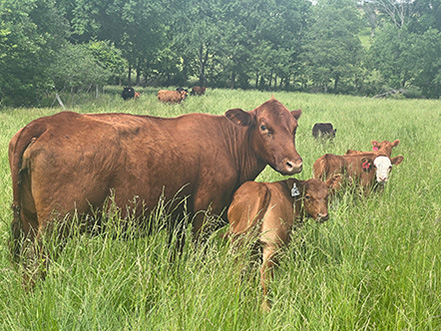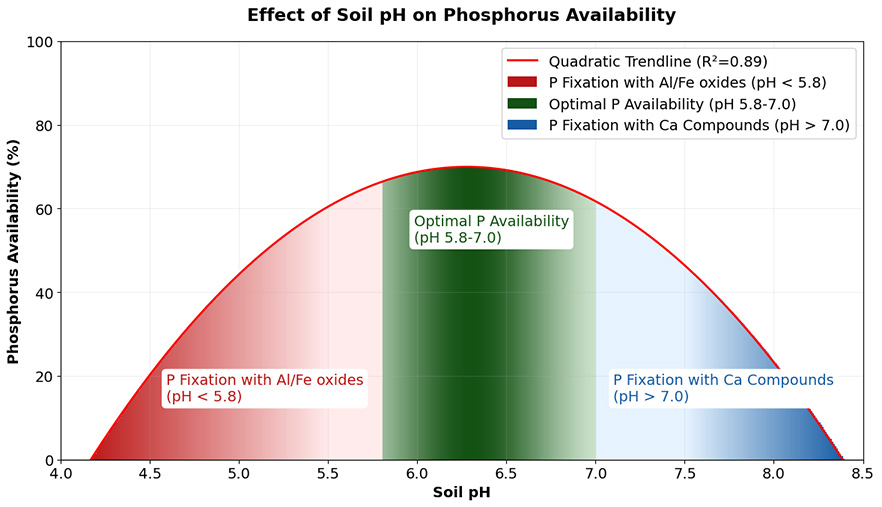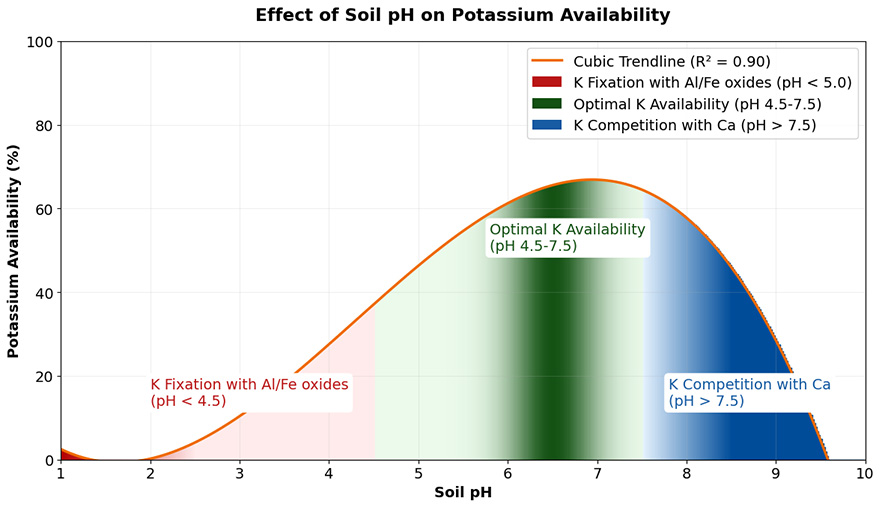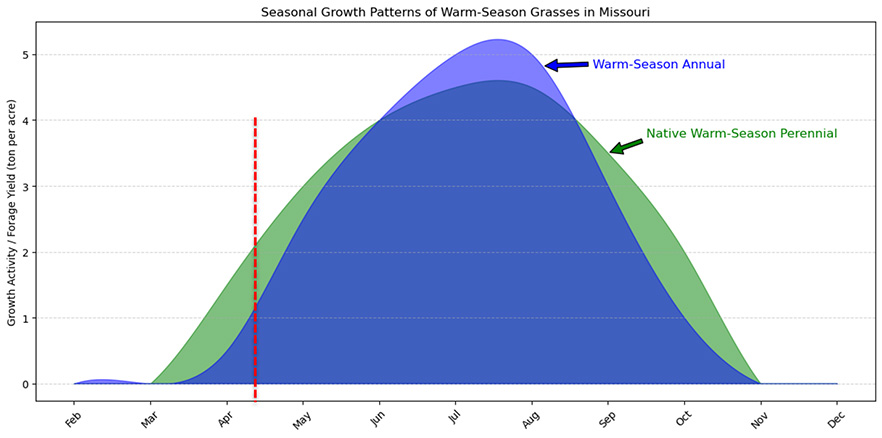
Maintaining healthy forage for livestock requires understanding the specific needs of soil and grass. Warm-season forage grasses, including native species like Big Bluestem, Switchgrass, and Bermuda grass, are important for livestock nutrition, soil conservation, and sustainable land management in Missouri. These grasses grow well in Missouri’s climate but require precise soil testing and fertilization strategies to balance productivity with ecological resilience. To ensure optimal growth and forage quality for livestock, testing soil and applying the right fertilizers based on soil test report at the right time are essential.
Soil testing is non-negotiable
Soil testing is a critical step in forage management, providing valuable information about soil pH, nutrient levels, and organic matter content. It helps identify deficiencies or excesses in essential nutrients like nitrogen (N), phosphorus (P), and potassium (K), which are vital for forage growth. Without this information, fertilizer applications may not address the forage's needs, resulting in poor grass health and wasted resources. Proper soil sampling techniques involve dividing the field based on variability, avoiding areas near shade trees, watering areas, feeding areas, and roads, and collecting samples in a zigzag pattern. Separate samples should be taken for different management areas or different crops and problem areas.
We recommend testing soil every 3 years, ideally in late winter (February–March) to allow amendments to integrate before spring growth. For forage systems, soil samples should be taken at a 6–8 inches depth. It is advisable to collect 10-15 soil samples from different parts of the field, properly mix them, and send 2 cups of the mixed soil with proper label to the soil testing lab. In uniform fields, a composite sample can be collected for every 15-20 acres. Regular soil testing helps track soil fertility trends and adjust management practices, minimizing production costs and maximizing yield potential.
Consequences of low and high pH on nutrient availability
Soil pH significantly influences the availability and uptake of nutrients by forage. Most warm-season forages prefer a soil pH between 6.0 and 6.5, though they can tolerate slightly acidic soils. Maintaining a soil pH within the optimal range is critical for efficient nutrient utilization and healthy forage growth.
1. Nitrogen (N): The optimal soil pH range (6.0-7.0) maximizes nitrogen availability, with reduced losses and better nutrient uptake. At pH levels below 5.5, ammonium dominance leads to reduced nitrification, limiting nitrogen availability. In alkaline soils (pH > 7.5), nitrogen volatilization increases, resulting in significant nitrogen losses. Severe losses occur at pH levels above 9.5.

2. Phosphorus (P): The optimal range for P availability is between pH 5.8 and 7.0. In acidic soils (pH < 5.5), phosphorus tends to bind with aluminum and iron oxides, reducing its availability to plants. On the other hand, in alkaline soils (pH > 7.0), phosphorus reacts with calcium compounds, leading to further fixation and reduced plant uptake.

3. Potassium (K): The K availability is generally optimal within a soil pH range of 4.5 to 7.5. Although potassium (K) availability is less affected by pH compared to phosphorus or nitrogen (N), extremely acidic or alkaline soils can still reduce its effectiveness. In strongly acidic soils (pH < 4.5), potassium can become fixed by aluminum and iron oxides, limiting its accessibility to plants. Conversely, in alkaline soils (pH > 7.5), potassium availability may decrease due to competition with calcium.

4. Micronutrients: In acidic soils (pH 5.5-6.5), micronutrients like iron, manganese, copper, and zinc are more soluble and thus available for plant uptake. However, excessive acidity (pH <5.5) can lead to toxic levels of certain micronutrients, such as aluminum. In alkaline soils (pH>7.5), micronutrients such as iron, manganese, copper, and zinc become less soluble and are less available to plants, potentially leading to deficiencies.
Best time to fertilize warm-season forage
Fertilization timing is crucial for the growth and health of warm-season forages. These grasses should be fertilized when they are actively growing, typically from mid spring to summer (April to June) in Missouri. Applying fertilizer too early can benefit weeds, as they may outcompete the forage for nutrients. Additionally, early application can lead to higher nutrient losses because the plants are not yet ready to uptake the fertilizer efficiently. Hence, fertilization can be timed using soil temperature, growth stage, or calendar date.
1. Based on Soil Temperature
Warm-season grasses initiate active growth when soil temperatures consistently reach 60°F at a 4-inch depth (usually in April to early May depending on location). Applying fertilizers when the soil is warm ensures the nutrients are effectively utilized by the forage. Monitoring soil temperature using soil thermometer or other available soil temperature measuring devices ensures that fertilizers are applied when the forage can effectively utilize the nutrients.
2. Based on Growth Height
A reliable indicator of readiness for fertilization is grass height. Fertilizing warm-season forages at the appropriate height ensures optimal growth and nutrient use efficiency. For warm-season annuals like sorghum-sudan, millet, and crabgrass, applying fertilizer when the plants reach 4 to 6 inches in height supports rapid vegetative growth and tillering. While native warm-season perennial grasses such as big bluestem, switchgrass, and indiangrass benefit from fertilization at a height of 10 to 16 inches. At this stage, their root systems are well-established, allowing efficient nutrient uptake. It is recommended to apply nitrogen fertilizer in split applications.

3. Based on Timing
- Mid Spring: Applying 50% of the recommended nitrogen fertilizer at green-up, when grasses show signs of active growth, can improve nutrient uptake and minimize losses.
- Mid-Summer: Applying the remaining 50% of nitrogen in June can improve summer forage yield.
- Late Summer: Avoid applying fertilizers after July to allow grasses to prepare for dormancy and minimize the risk of winter damage.
pH management and soil amendments
If soil pH falls outside the optimal range, corrective actions can enhance nutrient availability:
- For acidic soils: Apply lime in fall or winter based on soil test recommendations to gradually raise pH.
- For alkaline soils: Apply elemental sulfur to lower pH over time. Organic amendments like compost or biochar can also improve soil structure and nutrient retention.
Testing soil and understanding its pH are essential for maintaining healthy forage. By applying fertilizers based on soil test results and aligning with appropriate growth stages, forage productivity can be maximized, ensuring high-quality forage for livestock.
For more information, please contact Rudra Baral, Agronomy Specialist, University of Missouri Extension via email at rudrabaral@missouri.edu. More articles can be found by visiting MU Extension Publications.
References
Baral, R. (2025). Maximizing Summer Grazing: A Guide to Warm-Season Forage Management in Missouri. University of Missouri Extension. Retrieved March 24, 2025.
Keyser, P. (2014). Fertility management for native grass forages. In Managing native grass forges. Center for Native Grasslands Management, University of Tennessee System. Retrieved March 24, 2025.
O’Kennedy, S. (2022). Soil pH and its impact on nutrient availability and crop growth. Int. J. Geogr. Geol. Environ, 4, 236-238.
Barrow, N. J., & Hartemink, A. E. (2023). The effects of pH on nutrient availability depend on both soils and plants. Plant and Soil, 487(1), 21-37.